Do you have a question about the Suzuki LT-R450 2006 and is the answer not in the manual?
Explains WARNING, CAUTION, NOTE meanings and rider age restriction.
ATV is hazardous, requires caution; no passengers, paved surfaces, public roads, stunts.
Importance of wearing protective gear and inspecting the ATV before riding.
Procedures for safe operation on hills, crossing obstacles, and through water.
Techniques for controlling skids and slides for rider safety.
Information on tire types, pressure, and vehicle load limits.
Dangers of improper accessories and modifications to the ATV.
Premium unleaded fuel requirements, MTBE, ethanol, and methanol limits.
API/JASO classification and SAE viscosity recommendations for engine oil.
Recommended 50:50 coolant mixture with distilled water.
Diagrams identifying controls and indicators on the handlebars.
Information regarding the ATV's ignition key.
Functions of the OFF, ON, and LIGHTS positions of the ignition switch.
Descriptions of the fuel level and neutral gear indicator lights.
Explanation of the FI and engine coolant temperature warning lights.
How to operate the 5-speed transmission and shift gears.
Operation of the clutch lever and parking brake lock.
Operation of the dimmer switch, engine stop switch, and starter button.
Operation and adjustment of the throttle and front brake levers.
Adjusting the throttle limiter for engine power control.
How to apply the rear brake.
Instructions for opening and closing the fuel tank cap.
Procedures for removing and locking the seat.
Adjustment by dealer recommended; involves adjuster ring position.
Location of a bracket provided for mounting a flag.
Adjusting rebound and compression damping forces individually.
Adjustment by dealer recommended; involves adjuster ring position.
Adjusting rebound and compression damping forces.
What to know, inspect, and wear before riding.
Hazards of young riders and operating under alcohol/drugs.
Finding practice spots and learning controls without looking.
Importance of proper tire pressure and vehicle inspection.
Dangers of improper accessories, modifications, and cargo loading.
Checks for steering, brakes, tires, fuel, lighting, etc.
Helmet, eye protection, gloves, boots, and protective clothing.
Throttle limits, speed variation, oil circulation, and first service.
Steps for starting the engine when cold or warm.
Hazards of carrying passengers and riding on pavement.
Hazards of riding on public roads, at excessive speeds, or attempting stunts.
Importance of posture and caution on rough/slippery terrain.
Caution on unfamiliar terrain and safe parking brake release.
How to brake, shift gears, and use the throttle safely.
Steps for parking the ATV securely.
How to turn safely due to the solid rear axle.
Techniques for managing skids, slides, and advanced turns.
Hazards of steep hills and safe climbing practices.
Maintaining steady speed and shifting body weight uphill.
Hazards of stalling or rolling backward on hills.
Steps to turn around if unable to reach the top of a hill.
How to safely go down hills.
Procedures for safely navigating obstacles and slopes.
Risks of deep water and impact on brakes.
Checks for cold weather and battery jump-starting risks.
Hazards of wet brakes and risks of hypothermia.
Proper clothing recommendations and risks of snow/ice riding.
Care on snow/ice and use of eye protection.
Weight limits, secure mounting, and cargo distribution.
Dangers of improper accessories and modifications to the ATV.
Summary of maintenance intervals for key components.
Schedule for air cleaner, oil, brakes, tires, chain, etc.
Hazards of improper maintenance and need for frequent service.
Recommendation to use genuine parts for ATV longevity.
Battery maintenance, charging rates, and hydrogen gas hazard.
Checking plug type and proper installation procedures.
Limits for battery charging rate and polarity warnings.
How to install a spark plug and protect the spark plug hole.
Steps to remove the fuel tank and hoses.
Steps to remove the spark plug.
Procedures for cleaning and gapping the spark plug.
Adjusting idle speed and related hazards.
Adjusting throttle and choke cable play.
Hazards of inadequate throttle cable play.
Recommendation to replace fuel hoses every 4 years.
Importance of oil and procedure for checking the oil level.
Steps to check oil level using the dipstick.
Steps to change the engine oil and filter.
Dangers of using too little or too much engine oil.
Steps for draining the engine oil.
Risks of new and used oil for humans and pets.
Steps to replace the oil filter and installation cautions.
Refilling oil and using correct oil specifications.
Cleaning importance, inspection, and hazards of operating without element.
Procedures for removing and cleaning the air cleaner element.
Dangers of using a torn air filter.
Importance of correct placement and sealing for the element.
Hazards associated with contact with oil and solvent.
Checking the drain tube for accumulated fluids.
Adjusting the clutch cable play.
Hazards of improper disposal of drained oil or gasoline.
Checking chain condition, cleaning, and kerosene hazards.
Cautions on cleaning fluids, lubricants, and slack adjustment.
Adjustment steps and drive chain wear indicator check.
Hazards of improper adjustment or tightening.
Checking coolant level and hazards of hot coolant.
Tire specifications, tread wear limits, and load capacity.
Hazards of improper tire pressure and worn tires.
Recommended tire pressures and how to measure them.
Dangers of overinflating tires and care during replacement.
Hazards of incorrect tire installation.
Importance of proper brake system inspection and maintenance.
Checking fluid, correct type, health risks, and spill damage.
Checking pad wear, replacement, and hazards of brake repair.
Adjusting rear brake pedal position and brake light switch.
Steps for adjustment and associated hazards.
Procedures for wheel removal, torque specs, and loose nut hazards.
Periodically retightening rear axle nut and hot muffler hazard.
Steps for removing, cleaning, and inspecting the spark arrester screen.
Steps to replace headlight bulb and related cautions.
Fuse locations and hazards associated with replacement.
Lubrication importance and warning against lubricating switches.
Checking the fuel system for starting issues.
Troubleshooting steps for engine stalling issues.
Hazards associated with performing the spark test.
Importance of changing engine oil for winter use.
Procedures for transporting and securing the ATV safely.
Methods for preparing and washing the ATV.
Post-cleaning checks, wet brakes, and storage preparation.
Benefits of cleaning and risks of using high-pressure washers.
Washing methods and hazards of operating with wet brakes.
Steps for storing vehicle components for long periods.
Risks associated with draining fuel.
Steps for preparing the ATV for service after storage.
Where to find frame and engine serial numbers for documentation.
Importance of reading and keeping warning labels on the ATV.
Hazards of improper tire pressure and overloading the vehicle.
Overall size, engine details, and drivetrain specifications.
Suspension, brakes, electrical system, and fluid capacities.
| Brand | Suzuki |
|---|---|
| Model | LT-R450 2006 |
| Category | Offroad Vehicle |
| Language | English |
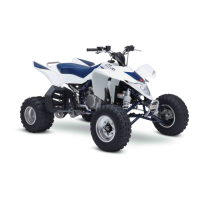
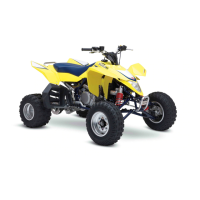


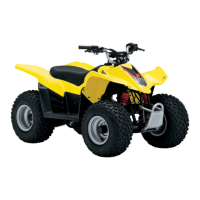

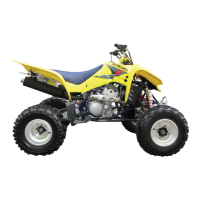



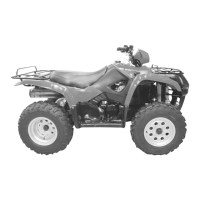
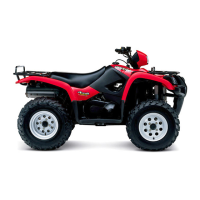
